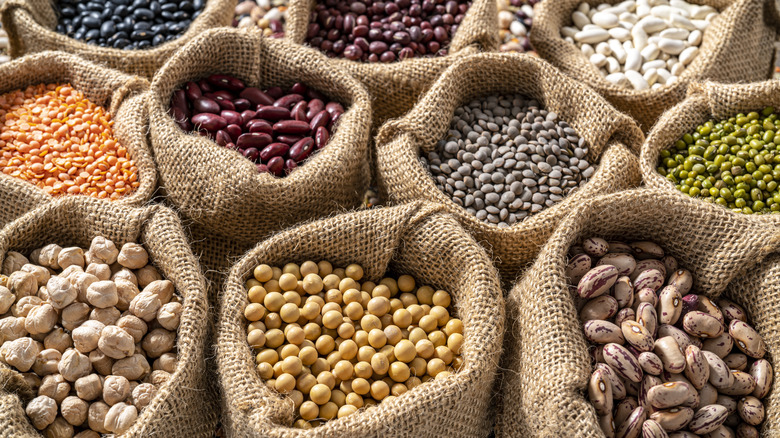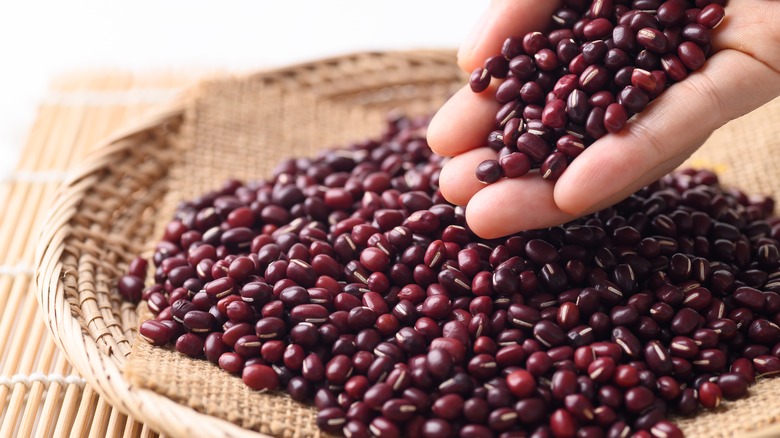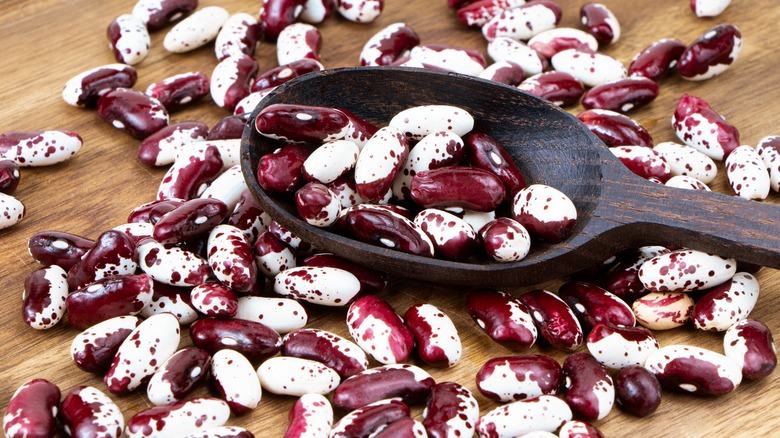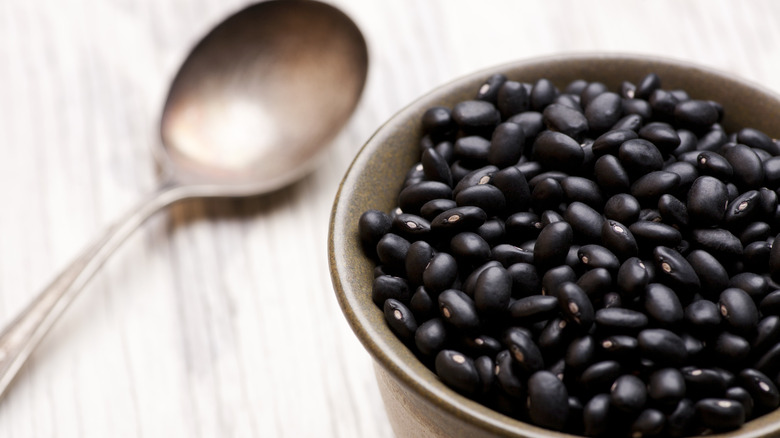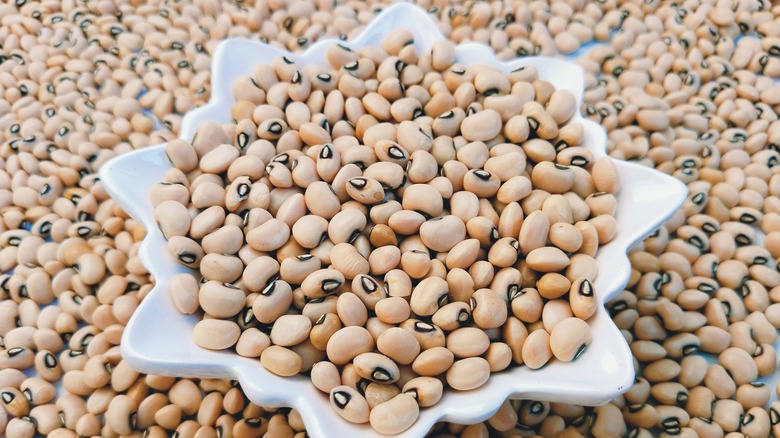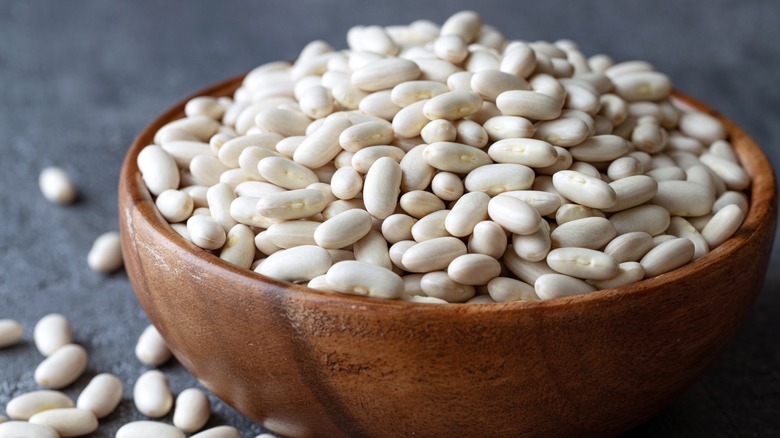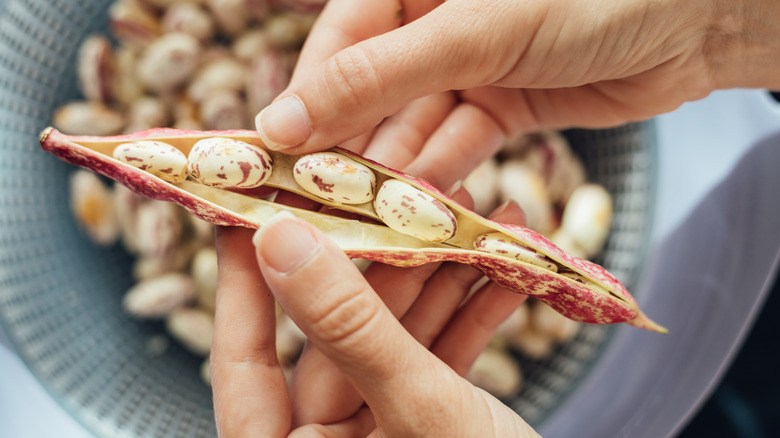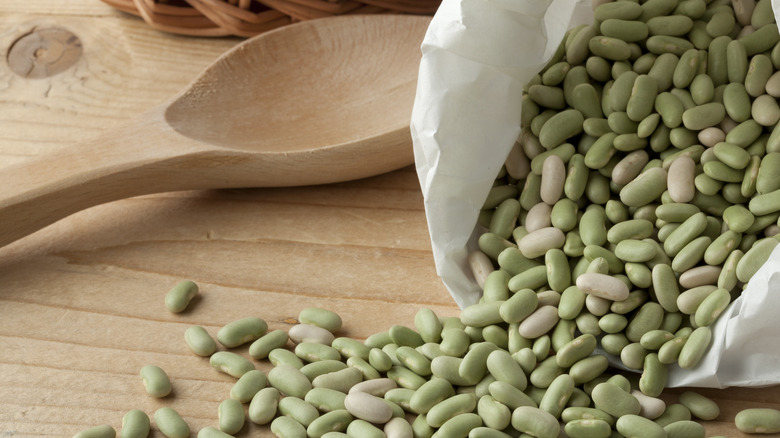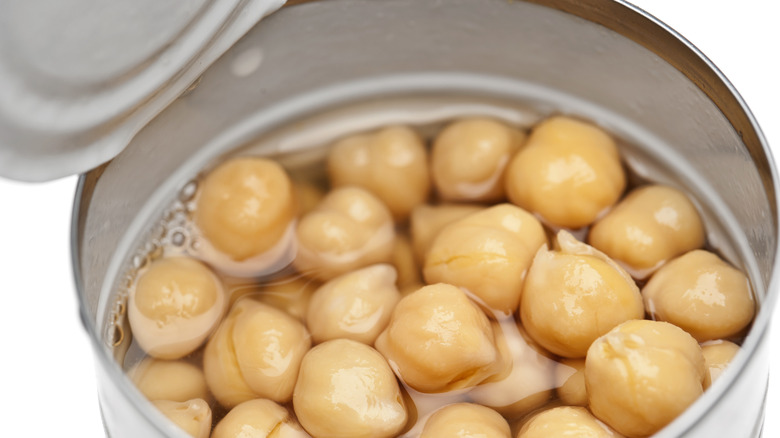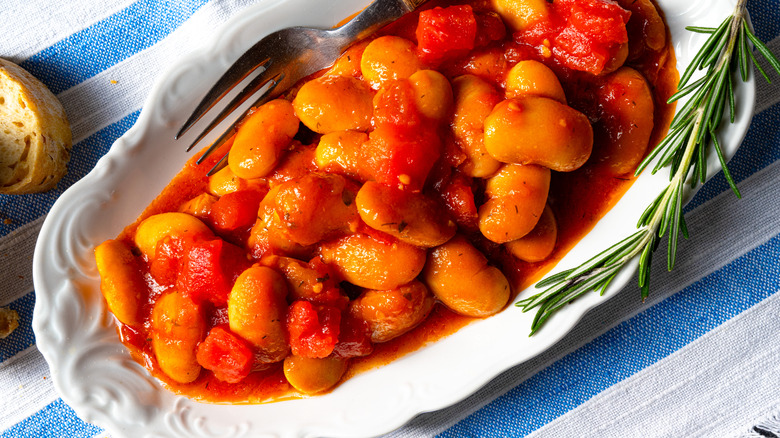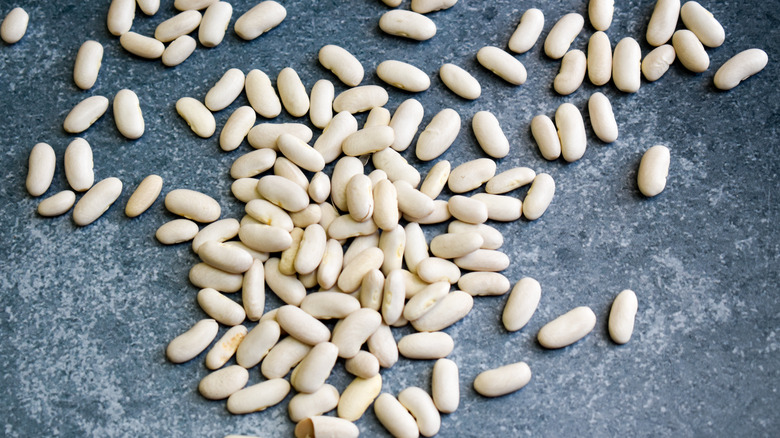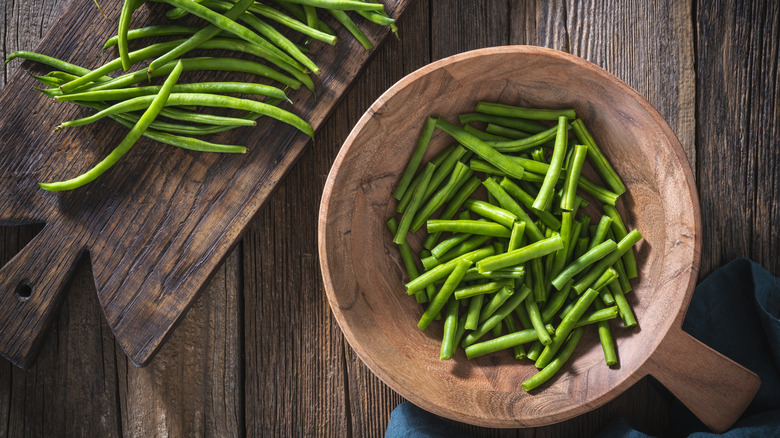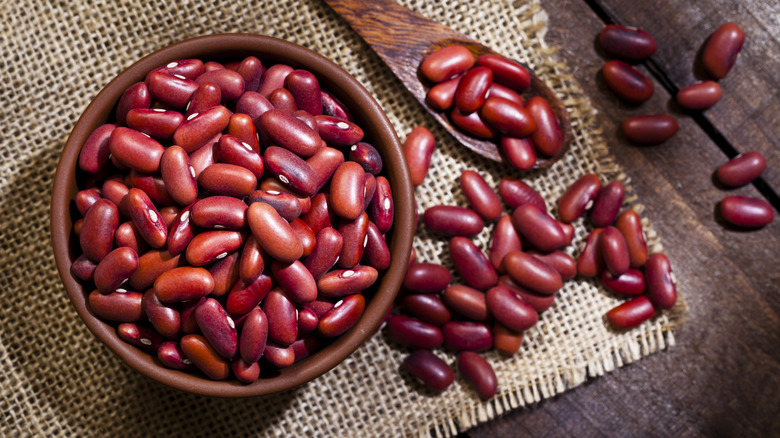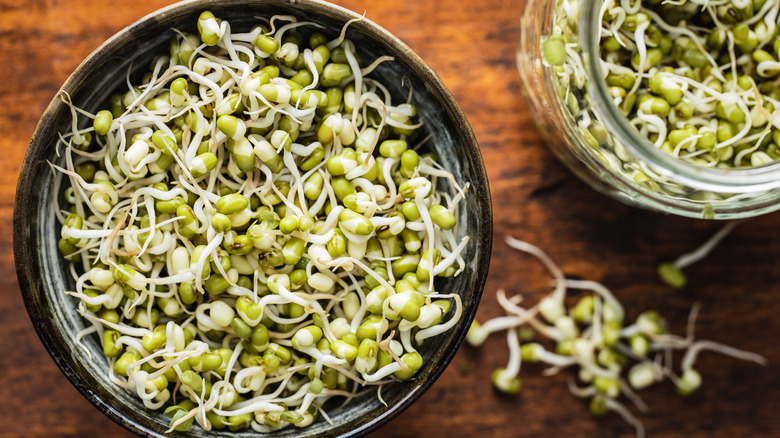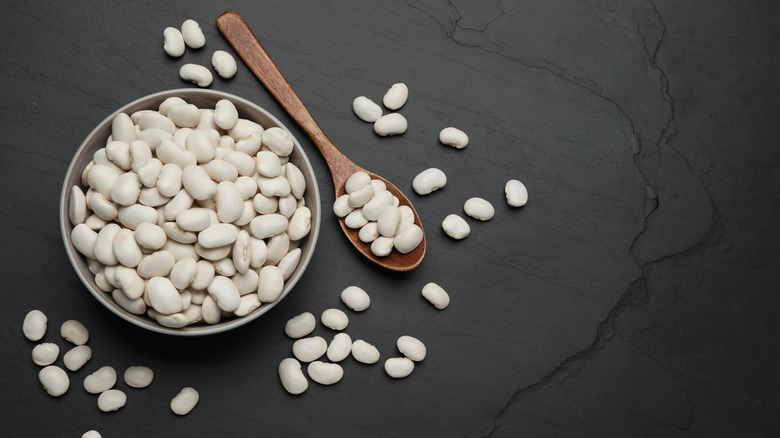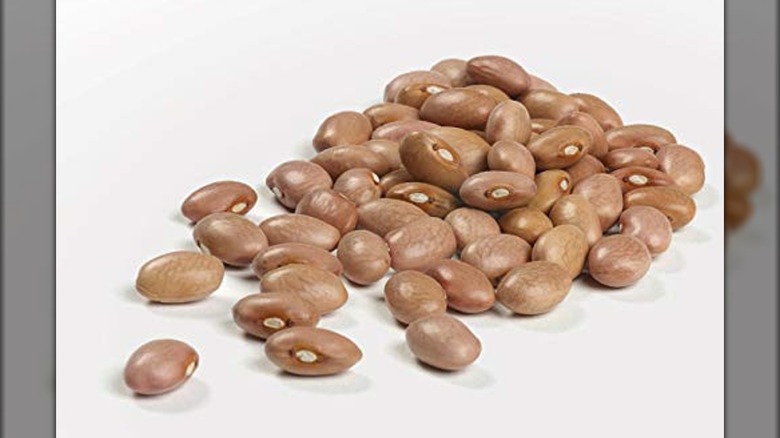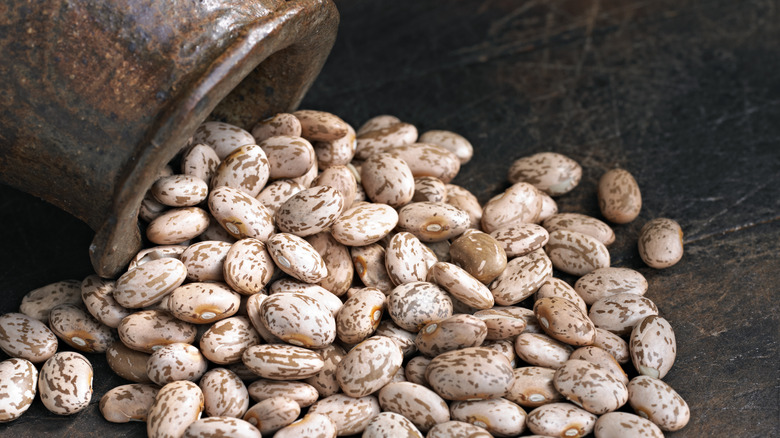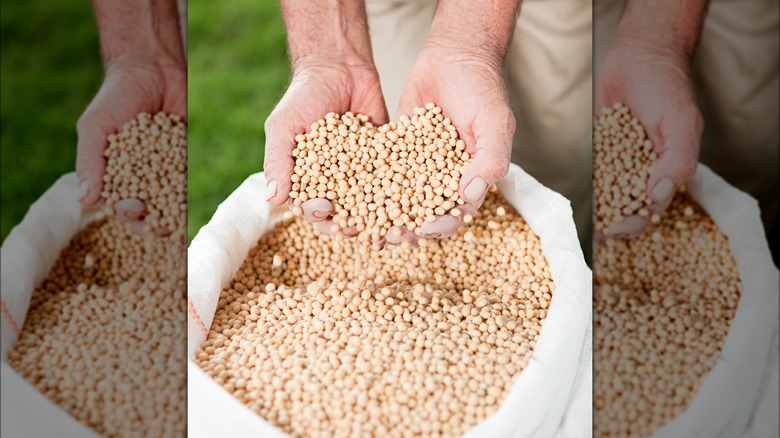17 Types Of Beans And How To Use Them
Believe it or not, there are more than 400 different varieties of beans that can be found around the world. Beans, which are actually the seeds of the Fabaceae family's flowering plants, often grow in a pod. They are a member of the legume family, along with peanuts, lentils, and peas. Beyond the distinct flavors, Medical News Today shares that beans can be an excellent source of amino acids, antioxidants, and protein. They can add bulk to a recipe and help you stay full for longer without consuming as many calories. Adding them to your meal rotation will be a win-win in terms of both taste and health.
Beans can make a wonderful addition to soups and stews, be added to top a salad, pureed to make dips, and so much more. With so many different varieties of beans, there's certainly no lack of options to try. However, different varieties do offer different flavors and textures and may be better suited for certain recipes than others. If you'd like to explore some of the most popular types of beans and learn more about how you can start incorporating them into your meals, keep reading.
Adzuki beans
Adzuki beans are grown in the Himalayas and in various parts of East Asia. While red is the color you're most likely to see, they can be several different colors. You might also hear adzuki beans called aduki beans, azuki beans, or red mung beans. According to Healthline, these beans offer several nutritional benefits, from their low-fat content to their high fiber and protein levels. They are also a good source of important vitamins and minerals, including folate, manganese, zinc, and magnesium. Eating them may help support healthy digestion, lower the risk of developing diabetes, and support healthy weight loss.
Adzuki beans have a very sweet flavor, which means that you're more likely to find them featured in dessert recipes than in lunch or dinner options. One of the most popular ways to use them is to make red bean paste. This Japanese dish is used in a variety of recipes, including cakes and ice cream. The beans are boiled, mixed with sugar, and ground down into a sweet paste. You can also try adding adzuki beans to soups, using them to make a vegan curry, or even boiling them to make tea.
Anasazi beans
Anasazi beans are named after the Anasazi Native Americans who lived in present day New Mexico, Colorado, Utah, and Arizona (along the four corners region where these states meet). The Anasazi, who were in this region as early as 130 A.D., are known for their architecturally impressive cliff dwellings, but we can also thank them for the Anasazi beans. Settlers in the region discovered these beans among the ruins in the early 1900s. Today, they are still grown in the same area where the Anasazi once lived.
Anasazi beans — which may also be called Appaloosa beans — have a unique flavor. They're often used in Mexican and Southwest dishes, which makes sense, given where they originate from. You might try using them to make refried beans, add them to a pot of chili, or make a filling soup or stew using them. Compared to some other varieties of beans, this type has a thinner skin, which means that they don't take as long to cook.
Black beans
If you've walked through the grocery store, then you already know that black beans may be sold canned, dried, or even puréed. The slightly sweet and delicious flavor makes a wonderful addition to your Tuesday night taco, be added to top a salad, be used to make burgers, and so much more.
There are several reasons you might want to start cooking with black beans more frequently beyond the incredible dishes you can make with them. The beans offer high levels of important nutrients like magnesium, calcium, phosphorus, zinc, and copper, which means that they can help facilitate a healthier bone structure, as Medical News Today shares. Adding more black beans to your diet may also help lower your blood pressure thanks to their lower sodium levels and their nutrient profile with calcium, potassium, and magnesium. Eating these beans may also help support a healthy heart, keep diabetes under control, aid with digestion, and more.
Black-eyed peas
When you look at a black-eyed pea, you can probably figure out where their name came from. These beans are light brown with a black spot — or eye — on their side. According to BlackDoctor.org, black-eyed peas pack a lot of nutrients that can make them a healthy choice when planning a meal. As a low-fat and low-calorie food, they can support individuals looking to lose weight. They are also protein-rich, supporting cell growth and healthy muscles, hair, skin, and nails. These beans also deliver iron, potassium, and vitamin B to the body.
It is believed that the beans were originally grown in North Africa before being introduced to the Americas by explorers and/or enslaved individuals taken from Africa and brought to North America. You may also see black-eyed peas referred to as goat peas or southern peas, even though this bean is not really a pea. You're most likely to find dried black-eyed peas at the grocery store, though they can also be sold canned or even cooked. They have a rich, meaty flavor and can pair nicely with other heavier entrées, such as ribs.
Cannellini beans
Cannellini beans — which originated in Italy — are white beans known for their mild flavor that pairs nicely with different recipes. You can find both canned or dried varieties of these beans at most grocery stores and will find that they are both easy to cook with and add a nice taste and texture to your entrées. If you're cooking dried beans, you'll want to make sure to soak them in water for at least 5 or 6 hours before cooking them. This will allow the beans to rehydrate and expand to make sure your dish turns out as desired. Cannellini beans are one of the signature ingredients in minestrone soup, but they'll also work well in other soups and stews.
Healthline explains that white beans like cannellini beans are an excellent source of fiber, protein, vitamin B6, magnesium, phosphorus, and folate. As a nutrient-dense food that is high in fiber, cannellini beans may also be able to support a healthy body weight by helping individuals feel full after each meal.
Cranberry beans
If you're looking to find a hearty and meaty bean to make satisfying soups, stews, and other meals with, then you might want to give cranberry beans a try. These beans are prominently featured in many Portuguese and Italian dishes, where you may also see them referred to as borlotti beans. As VeryWell Fit points out, with less than 1 gram of fat per serving, cranberry beans are a low-fat food. They are also high in protein, offering 9.3 grams per serving, which is more than you'll get from a serving of some other bean varieties. These beans also offer a high percentage of the daily recommended intake for vitamins and minerals such as folate, manganese, thiamin, iron, phosphorus, and magnesium.
In addition to their health benefits, cranberry beans will make for a scrumptious addition to a range of recipes, such as chili, soup, pasta, salad, and so much more. They'll even taste great when served by themselves as a side or main dish. When cooked, the beans have a softer texture and thinner skins than some other varieties, making them a bit creamer.
Flageolet beans
The Louis Bonduelle Foundation explains that despite their smaller size, flageolet beans pack a real punch in terms of their nutritional content. Eating just one serving of the beans will help you get half of your recommended daily value of fiber. But fiber isn't all these beans have to offer. They are also a good source of essential nutrients, such as magnesium, iron, copper, manganese, potassium, and vitamin B9.
Flageolet beans come from France, where they are the centerpiece of many dishes. They can make a wonderful side dish for lamb, chicken, or seafood. The beans have a very pale green color and a more mild flavor than some other nuttier and richer bean varieties. Unfortunately, if you want to try flageolet beans, you might have difficulty finding them. Though some are grown in California, they are less common in the United States. If you do find some available, just be prepared to spend a little more for this bean than for some of the others that are more easily accessible on grocery shelves.
Garbanzo beans
If you don't think you've heard of garbanzo beans, it may just be that you know them by their other name: chickpeas. You can find canned or dried chickpeas in most grocery stores. If you're preparing dried garbanzo beans, soaking them for three or more hours can help them cook more quickly and reduce the bloated feeling that some experience after consuming beans. Once cooked, you can toss a few of the beans into a salad, soup, or stew, season and roast them, or blend them to make hummus.
MedicalNewsToday notes that the high protein content of garbanzo beans makes them an excellent choice for vegans or vegetarians who are not eating meat. Each cup of these beans offers nearly a third of the protein adults should consume each day. The beans are also high in fiber, which can help support healthier cholesterol levels, decrease the risk of heart disease, aid with healthy digestion, and so much more. They are also a great source of iron and calcium to support healthy bones.
Gigante beans
As you may be able to guess based on their name, gigante beans are larger than many other varieties. Hellenic Grocery highlights that on top of their superb flavor, gigante beans are quite healthy. Like other varieties, they are a good source of fiber to support digestion. They also contain many essential vitamins, such as A, B, C, E, and K.
The beans come from Greece, where they are the star ingredient in gigantes plaki, a popular side dish. Made with tomatoes, olive oil, and the gigante beans, this dish is slow-cooked for a soft texture and crispy edges. You could also substitute gigante beans in place of other varieties when making soups, stews, and more. Before adding gigante beans to a recipe, it is recommended to soak them overnight. This will help rehydrate them, shorten the cooking process, and ensure the finished result is soft, tender, and delicious.
Great Northern beans
Great Northern beans are another type of white bean. They are smaller in size and offer a more mild flavor. You can easily substitute Great Northern beans in recipes that call for navy beans or cannellini beans since all three of these beans share a similar texture and relatively subtle flavor. One popular way to cook with Great Northern beans is to add them to stews and soups. Even after hours of simmering with the other ingredients, the beans will maintain their shape. Because of their more subtle taste, using them in soups and stews is also a good way to make a bulkier and heartier meal without detracting from the other flavors in the dish.
Great Northern beans can be a healthy addition to your recipes. VeryWell Fit explains that they are a low glycemic food, meaning they won't have a major impact on a person's blood sugar. They are also low in fat and high in protein. The beans are an excellent source of folate, manganese, iron, magnesium, copper, and thiamin.
Green beans
Green beans are another member of the legume family. They grow on vines and may also be referred to as snap beans or string beans. The Nebraska Extension shares that they offer several nutrients that are good for the body, including fiber to aid with digestion and vitamin K to support healthy bones and blood clotting. Green beans are also a good source of folate, which is an essential nutrient for pregnant women but also important for supporting tissue growth in all individuals.
There are several varieties of green beans available. Blue Lake beans are the variety that you're most likely to find at the store, especially if you're buying canned or frozen beans. Haricot verts are another variety, originating from France, that are longer and thinner than some other varieties. It is easy to cook fresh green beans. You can simply steam the beans, and they'll be ready and delicious in minutes. Plus, you don't need to add any butter or other sauces that could cancel out the nutritional benefits.
Kidney beans
Kidney beans originated from Ecuador and Northern Peru. They can be found in a range of sizes and colors, including white, red, and black. It is important to note that some kidney beans, particularly the red varieties, are considered poisonous if consumed raw. Similarly, after soaking the beans, you should always discard the water and rinse them again before cooking. This way, you won't be introducing the compounds that could cause intestinal upset back into your recipe. Aim to soak the beans overnight for the best results. You can use kidney beans in a variety of ways, including making chili with them, adding them to a soup, using them to top a salad, or puréeing them to make a dip.
Healthline shares that there are many nutritional and health benefits associated with eating kidney beans. They're a high-protein food; 27% of their caloric content is due to the nearly 9 grams of protein in each serving. The beans are also a good source of fiber, folate, iron, copper, molybdenum, manganese, potassium, and vitamin K1.
Mung beans
Originating from India, mung beans are another healthy and nutritious option you might want to try. The beans are small and green with a hint of nuttiness and sweetness. According to Healthline, taste isn't the only reason you might want to try incorporating mung beans into your recipes. They contain flavonoids, phenolic acids, and other antioxidants that can help you neutralize free radicals and protect your cells, potentially decreasing the risk of inflammation, heart disease, and even certain types of cancers. Mung beans can also contribute to healthier blood pressure thanks to the fiber, potassium, and magnesium they contain.
You're most likely to find mung beans featured in Indian and East Asian recipes, though you can certainly use them for other cuisine types at home. Some of the many ways to try incorporating mung beans into your diet include adding them to a soup recipe, grinding them up and making your own flatbread recipe, puréeing them to make a spread, or just cooking up a batch with some seasonings to make a flavorful side or main dish.
Navy beans
Given their name, you might visualize a blue bean when you hear about navy beans. However, they didn't earn their name based on color but rather because they were one of the main food items eaten by members of the United States Navy during the early 1900s. The beans have a creamier ivory/white color, closely resembling cannellini beans and Great Northern beans. However, navy beans are actually smaller in size and less oval-shaped than these two other varieties. Their texture is rather smooth and silky, and they add a hint of nuttiness to recipes. Dried navy beans should be soaked for a minimum of 6 hours before cooking. This will help make them easier to digest and aid with the cooking process.
Healthline notes that the beans offer numerous health benefits. Each serving offers a whopping 19.1 grams of fiber, which can support metabolic processes. Adding navy beans to an otherwise healthy diet may help lower cholesterol, aid with weight loss, and more.
Pink beans
You're most likely to find pink beans if you live in the western part of the country or in the Caribbean. As their name suggests, these beans are pink in color with a small, oval shape. The beans are sometimes called chili beans or Habichuelas Rosadas. Thanks to their flavor and texture, pink beans can complement various dishes nicely. They are nice and smooth and can give a powdery-like texture to various dishes. The beans are also a little sweet.
One of the most common uses for pink beans is for making refried beans. Chili con carne is another entrée that is often prepared using them. However, when using pink beans at home, don't feel like you have to limit yourself to more traditional recipes. You'll find that pink beans can add just the right flavor to your favorite soup, bean dip, salad, and so many other recipes. If you're making a recipe that calls for pinto beans, red beans, or kidney beans, try substituting pink beans in it — they offer a similar flavor and texture to these other beans.
Pinto beans
Pinto beans are commonly served with Mexican dishes, which shouldn't be surprising when you learn that the beans grow natively in Central and South America. As with other types of beans, pinto beans can make a nutritious addition to a diet. VeryWell Fit explains that they are a low-calorie, sodium-free, cholesterol-free, and fat-free food. Consuming just one cup of beans provides you with nearly three-fourths of the folate your body needs daily, along with 15 grams of protein and 15 grams of fiber.
Pinto beans are light brown to cream and have darker, reddish-brown splotches. These splotches likely gave the beans their name, as pinto can mean spotted or painted. However, once cooked, you won't notice these spots anymore. Add pinto beans to burritos, use them to make refried beans, drop them into a favorite soup, or serve them as a flavorful side dish; you'll find many ways to enjoy these tasty beans.
Soybeans
Another member of the legume family that you might want to try is soybeans. While the beans were first grown in East Asia, today, they are grown in various locations worldwide — with about half of the production taking place in The United States. Although people use the term edamame interchangeably with soybeans, edamame is technically just a single type of soybean — those that are harvested while they are still green and immature as opposed to other varieties that are harvested at a darker color.
According to WebMD, soybeans can offer a range of benefits. First, they are an excellent source of protein, offering all nine of the essential amino acids our bodies require for the bones and muscles. This is a major distinction from many other plant protein sources that only offer some of these various amino acids. Soybeans contain a much lower percentage of saturated fat, with a much higher percentage of polyunsaturated (or good) fat. These omega-3 and omega-6 fats can help support a healthier heart.
